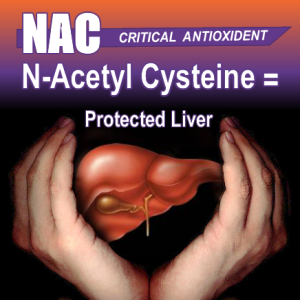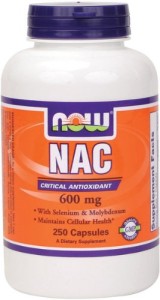One of my all-time favorite nutritional supplements is N-acetyl cysteine, known to most simply as NAC (pronounced: “knack”). Not only is a NAC a building block of the body’s most important detox molecule, glutathione, but it is also a very special and important detox and even medicinal molecule on its own. It’s a prescription drug called Mucomyst which is used by victims of cystic fibrosis to help clear out thick sticky mucoid secretion which clog unfortunate CF patient’s lungs and organs.  It can also improve lung function folks who are dealing bronchitis or emphysema or tuberculosis. And, it’s available in intravenous form as a medication called “Acetadote” which is used as an antidote Tylenol liver poisoning. According to an article published in the Cleveland Clinic Journal of Medicine, Tylenol or acetaminophen (which is the generic name for Tylenol) poisoning is the leading cause of acute liver failure in the United States, with nearly half of acetaminophen poisoning cases due to unintentional overdose. Even if you’re not dealing with acute, full blown liver poisoning taking a couple hundred milligrams a day of NAC might not be a bad idea if you’re taking Tylenol on a regular basis.
It can also improve lung function folks who are dealing bronchitis or emphysema or tuberculosis. And, it’s available in intravenous form as a medication called “Acetadote” which is used as an antidote Tylenol liver poisoning. According to an article published in the Cleveland Clinic Journal of Medicine, Tylenol or acetaminophen (which is the generic name for Tylenol) poisoning is the leading cause of acute liver failure in the United States, with nearly half of acetaminophen poisoning cases due to unintentional overdose. Even if you’re not dealing with acute, full blown liver poisoning taking a couple hundred milligrams a day of NAC might not be a bad idea if you’re taking Tylenol on a regular basis.
NAC is used in the food industry to protect butter and other fatty foods from going rancid. It seems to be especially protective against oxidation of fats. If you’re dealing with osteoporosis, NAC can protect bone making cells from oxidation. It can be helpful for folks dealing with kidney disease. In article published in the American journal of physiology in 1997, researchers concluded that NAC can reduce the impact of ischemic renal failure. Other researchers are exploring the use of NAC for chronic cystinosis, which is an accumulation of crystals in the kidney as well as the eye and the lymph nodes. And there are currently studies aiming to find out if NAC can be used to treat coon inflammation. Keep in mind now, all of these potential uses for NAC are independent of NAC’s important and most well-known role as a building block for the glutathione tripeptide molecule.
One of my favorite uses for NAC, which is truly a versatile detox supplement, is in a topical form to alleviate some of the toxicity associated with the acne medicine Benzoyl peroxide. There’s not a lot of topical medications for acne, you pretty much count all the approved topical acne meds on one hand and Benzoyl peroxide is pretty much the only medication for acne that you’re going to find in a drug store. It’s a rare acne sufferer who has not used Benzoyl peroxide containing products at least once, and most people who have acne are using it on a daily basis. It’s the stuff in proactive, most Neutrogena acne products and pretty much all Clearasil acne products too. The problem with Benzoyl peroxide is its somewhat extreme toxicity. The FDA regulate the amount of BPO (as Benzoyl peroxide is referred to), so theoretically at least, toxicity should not be a problem. The maximum percentage you can get of BPO is 5 per cent or 10 percent if you have a prescription and toxicity with includes tumors and cancer has only been shown to occur at high levels say, at 50 percent or higher concentrations, but do you really want to use any percentage of a known tumor causing agent. If you are using Benzoyl peroxide washes or creams you should now that you can protect yourself number one by supporting glutathione using the building blocks; glutathione is an important skin cell protector. But you should also know that you can use NAC on its own to protect yourself from Benzoyl peroxide toxicity. You can even use NAC to protect yourself from the irritation that Benzoyl peroxide can cause. Simply dump the contents of a 500mg NAC capsule into your favorite skin care cream, mix it in real well so it’s completely dissolved, and apply it to your face after you use your BPO. If you add some Vitamin E, you can stick a pin in a Vitamin E capsule and add the oil to your cream along with the NAC, you can even better anti-irritant effects. Of course taking NAC orally and Vitamin E for that matter can also help your body fight off some of the toxicity associated with Benzoyl peroxide. And because acne may be related to deficiencies in glutathione, taking NAC as a supplement may clear up your skin enough so that you won’t even need your Benzoyl peroxide products in the first place.
And that’s not the only topical benefits you can get form NAC. It turns out folks who have psoriasis may get at least some symptomatic relief form topical application of NAC. According to an article published in The Lancet in 1999 a 10 percent N-acetyl cream was shown to slow down the hyper growth of skin cells. Although this study was not done directly on psoriasis patients, given the non-toxic and gentle and healthy benefits associated with NAC it might be worth a try. One thing to keep in mind if you are going to make use of NAC cream for acne or psoriasis or simply as an anti-oxidant (which might not be a bad idea, given the numerous benefits associated with this interesting nutritional substance) you have to make sure to use it fresh. NAC breaks down pretty quickly and if you add it to your favorite lotion or cream and let it sit for more than10 or 15 minute, the sulfur component of NAC will be released and it can destroy the structure of your product, and it’ll probably give off a pretty stinky sulfur smell too.
You can support and improve the effects of taking NAC if you use it with selenium and alpha lipoic acid. A good daily dose of these three musketeers of detox is 500mg of NAC, 400micrograms of a chelated selenium and 400mg of alpha lipoic acid. Taking these nutrients with 100mg of Vitamin C (1000mg) and 400 i.e. of Vitamin E, (as mixed tocopherols) can provide even more detoxification and protective benefits.
Bet you didn’t know:
NAC’s important liver detox role makes it an important anti hangover alcohol clearing supplement. Take 500mg to 1000mg before you go out drinking and another 500mg when you get home and may another 500mg the next morning. Drink lots of waste and use the B-complex with each dose and you can eliminate or at least dramatically reduce the headaches and yucky feelings associated with alcohol overdose and toxicity.
Glutathione is a three part molecule made up of the amino acids cysteine, glutamine and glycine. In addition to getting cysteine from NAC, for maximizing glutathione production make sure you’re getting a teaspoonful of glutamine powder every day and using gelatin capsules, whey protein bone soup to get your glycine.
According to the folks at Memorial Sloan Kettering Cancer Center, NAC has benefits for reducing the symptoms of HIV/AIDS and cancer the toxicity associated with chemo- and radiotherapy.
NOW Foods N-Acetyl Cysteine

N-Acetyl Cysteine (NAC) is a stable form of the non- essential amino acid L-Cysteine. A sulfur-containing amino acid that acts as a stabilizer for the formation of protein structures, also necessary for the formation of Glutathione.
Molybdenum & Selenium are essential trace minerals that facilitate the production of several important enzymes.










